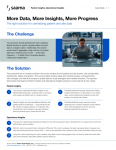More data will be generated in 2019 than in the last 5,000 years

“We continue to leverage rich data sources and apply analytics and machine learning,” said Jackie Kent, senior vice president, head of product, Medidata. “These strides allow us to impact the shape of clinical development,” and examples of these advancements are now being seen.
Kent cited Medidata’s recent collaboration with the Castleman Disease Collaborative Network, through which it was able to discover novel biomarkers for the rare disease. “Data sharing, through consortiums or other agreements, continues to be a positive impact on scientific insight and patients’ access to trials. The industry, as a whole, has the ability to improve on this,” she told us.
“Whether it is trial data or commercial data, the more sharing we do across the entire industry, the faster we can provide medicines to patients. Everyone has a stake in that game,” Kent said.
The promise of data
Looking to 2019, Joe Tyers, senior vice president of sales at Shyft Analytics, a Medidata company, said real-world data (RWD) will have a real-world impact
“From clinical hypothesis generation and outcomes analyses with the medical sciences teams to patient journey and market segmentation in commercial, RWD will become the industry’s data sources of choice,” he said.
With use-cases now available, Tyers said the industry will be able to deliver on “the promise of data,” including from clinical, claims, registry, and electronic medical record (EMR) data. This, he said, will “significantly compress the timelines to drug approval and lengthen its time in the market.”
According to Tyers, more data will be generated in 2019 than in the previous 5,000 years of humanity. Subsequently, to manage and best use these resources, he said, “augmenting biopharma’s reliance on legacy analytics approaches is at the top of the wish list.”
"At scale, organizations must centralize, integrate and automate data processes – from aggregation and master data management – to produce intelligence at rapid pace," Tyers added.
Partnering for innovation
To tackle this deluge of data, digital and analytics partnerships are increasingly emerging across the contract research organization (CRO) landscape.
“Tech partnerships across large- and mid-market CROs will drive mission-critical innovation,” said Tyers added, though when compared to other industries, life sciences lags in areas of digital migration, such as enterprise cloud adoption and artificial intelligence (AI), among others.
Tyers said, “By neglecting to incorporate technology and depending solely on professional services, clinical and commercial activity is reduced, and the pace of industry innovation is slowed.”
Despite these challenges, the advancement and approval of specialty and rare disease therapies continues to accelerate at “a fantastic pace,” he noted, adding that the growth of prescriptions for orphan drugs was nearly twice that of the overall pharmaceutical market in 2018.
“Innovation is alive and well in these areas of critically unmet need with products in this space, accounting for more than one out of every five prescriptions written worldwide by 2024,” said Tyers.
Improving patient outcomes
Also informing clinical development is the use of commercial data and insights, which Kent said allows customers to have more health outcome information. It is because of this need to connect clinical and commercial data that Medidata acquired Shyft.
Customers also are wanting to learn more about the patient burden. “Patient centricity as a way of improving patient outcomes will continue to be the goal for the industry in 2019,” said Kent.
Companies such as Medidata are using more and more data to ensure patients have access to a trial best suited for their disease, and one that was designed with their needs in mind, she added.
However, patient recruitment will continue to be a challenge in 2019. “We are all making strides to do better, whether you are a technology provider, a data provider, or a sponsor designing clinical trials, but it’s not solved yet,” Kent explained.
“This very old problem continues to be an issue that slows down getting new medicines to the market,” she added. “We have seen progress with virtual trials and with the introduction of new sources to capture patient data, but this challenge will still exist in 2019 and is something we will all be actively working on.”























